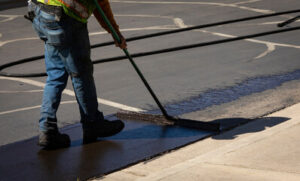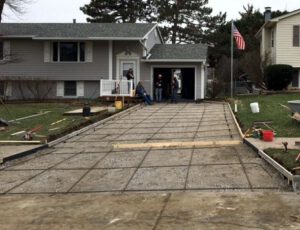Rochester NY Sealcoating is an essential part of asphalt maintenance that can extend the life of your driveway or parking lot. It’s essential to prioritize safety while working on a sealing project. This includes blocking off the area and protecting curbs, sidewalks, and other areas that the sealant may stain.
Asphalt is a popular material for parking lots and driveways due to its durability, strength, and resilience. However, the sun’s harmful UV rays can cause damage to the asphalt surface over time. This is because the UV rays penetrate the pavement and cause it to degrade and oxidize. Sealcoating helps to prevent this damage by creating a barrier that protects the asphalt from the sunlight.
It is recommended that you sealcoat your asphalt surface every few years to help extend its lifespan. This will help you avoid the costly repairs and replacements that would occur without a sealcoat.
The process of applying a sealcoat is relatively simple and quick. It starts with cleaning the asphalt pavement thoroughly. This is done with blowers, rotary brooms, and sweepers to remove any dirt or debris. Next, the cracks in the asphalt are blown out using compressed air. Finally, a hot rubberized crack filling compound is applied to the cracks.
Before the sealcoat can be applied, it is important to allow sufficient drying time. This will typically take 24 to 48 hours depending on weather conditions. It is also important to not use the pavement during this time period. If possible, it is best to have your sealcoat applied during the summer when there is less humidity and the temperatures are warmer.
Once the sealcoat has dried, the asphalt pavement will look brand new! This is because the sealcoat prevents water and chemicals from entering the small cracks that wear down the asphalt surface and the base beneath it. Additionally, the sealcoat keeps the asphalt flexible so it can expand and contract with the temperature changes without cracking.
As you can see, the benefits of sealcoating your pavement are numerous. It is an excellent way to protect your investment, enhance the appearance of your property, and extend the lifespan of the asphalt pavement. For more information about our services, or to schedule a consultation, contact us today. We look forward to hearing from you!
Prevents Water Damage
Asphalt driveways and parking lots are constantly exposed to harsh elements such as UV rays, moisture damage, weather and the wear and tear from vehicle traffic. To extend the life of your pavement, it’s best to keep them sealed on a regular basis with sealcoating. This is one of the easiest and most cost-effective steps you can take to protect your pavement.
One of the main causes of asphalt degradation is water. When water seeps into the cracks and holes in a slab of asphalt it quickly erodes the graded foundation that the road base and the asphalt itself sit on. This erosion can lead to cracks, potholes and even base course failures. If the problem isn’t addressed promptly it can result in expensive repair and replacement costs.
With a sealcoat, the surface is protected and moisture is deflected to the sides where it can evaporate more easily. This prevents the damage that is caused by constant contact with water and keeps your asphalt looking like new for longer.
Depending on your climate, you should have your asphalt sealed every two to three years. A sealcoat acts as a barrier that protects the pavement from harmful substances and chemicals. It also provides a sleek and attractive appearance that is sure to impress visitors to your home or business.
Before sealcoating, your pavement should be thoroughly cleaned to remove any oil or dirt. This is essential because if the area isn’t clean, the sealant won’t bond well to the pavement. You can use a gas blower, scrub brush and squeegee to clean your asphalt or hire a professional service to do it for you.
Once the pavement is clean, it’s time to apply the sealant. This can be done by using a hand sprayer, a larger commercial sprayer or by applying the sealcoat manually with a brush and squeegee. If you choose to do it yourself, you will need to invest in a good quality sealer and make sure that you follow the manufacturer’s instructions carefully. Once the sealant is applied, it should dry for 24 hours before you can start driving on it again.
Prevents Fuel Spills
Asphalt is a petroleum product and when auto fluids like gasoline and oil spill on it, the asphalt can oxidize and soften. Sealcoating protects the asphalt from these chemicals and keeps it looking good. It also provides a barrier between fuel spillages and the pavement surface which can promote safety for pedestrians, cyclists, vehicle drivers, and passengers.
During the application process, workers use standard PPE (personal protective equipment) including coveralls, gloves, safety glasses, and a face mask to avoid breathing in fumes or particles from the spraying machine. They start by sweeping and power washing the blacktop to remove any dirt, debris, or loose gravel. Any areas that aren’t being sealed need to be blocked off with cardboard and tape so they don’t get any sealer on them. Once the surface is clean and dry, workers can begin the application process.
The sealer is sprayed onto the blacktop and then broomed or squeegeed to ensure an even, thin coat. After the sealer has dried for about 24 hours, traffic can return to the area. If the weather is nice, a second coat can be applied the next day.
For the best results, sealcoating is done every three to four years for a commercial or residential driveway or parking lot. In addition to protecting the asphalt from damage, sealcoating is an inexpensive way to keep your property looking beautiful. It is much cheaper to preserve an asphalt lot with coal tar or asphalt emulsion than it is to overlay or replace the existing pavement.
The jet black color of sealcoating immediately upgrades the appearance of any pavement and helps it retain heat, which prevents deterioration. This makes it more pliable during the freeze-thaw cycle and helps it withstand Peoria’s harsh winters. The asphalt’s elasticity also helps it absorb the pressure of vehicles and not crack as easily. Lastly, the sealcoat’s oil-repelling properties help it resist stains from gasoline, car wash fluids, and motor oil. It’s important to choose a sealer with oil and fuel resistance, like CarbonSeal-FR, that has been laboratory tested. This will ensure the sealer has been proven to be resistant and will last longer.
Promotes Safety
In addition to enhancing the look of commercial property, well-maintained asphalt parking lots and driveways protect vehicles and pedestrians. They also reduce liability and save on costly repairs down the road. Choosing a reputable contractor and maintaining a regular schedule of maintenance services will ensure that your pavement is in top shape for the long haul.
A sealcoat is an effective barrier against damaging UV rays, harsh weather conditions, and automotive fluids. While a sealcoat cannot prevent all damage to your pavement, it can greatly slow the rate at which it occurs. A sealcoat is applied over existing pavement and dries into a dark black color that boosts the appearance of your property while protecting the surface from damage.
When auto fluids such as oil and gasoline spill on your parking lot, they can soak through the asphalt and cause serious damage to your tires, undercarriage, and engine. While you can clean up these fluids, it’s far easier to prevent them from penetrating the asphalt in the first place with a sealcoat.
The dark black color of a sealcoat helps to hide dirt and grime, and it keeps oil spills from staining your driveway or parking lot. In addition, a sealcoat will extend the life of your pavement and help you avoid costly repairs in the future.
Commercial asphalt sealcoating protects the surface of your parking lot, slows oxidation, and reduces cracking. Considering the amount of traffic on your commercial property, neglecting to apply a sealcoat can lead to expensive repairs down the road. Investing in your commercial parking lot by having a professional apply a sealcoat every three to five years will significantly prolong the life of your pavement, saving you money and reducing risk.
Whether you manage a shopping center, office building, apartment complex or homeowner’s association, your parking lot is the first impression visitors have of your business or community. A faded, cracked, or unappealing looking parking lot can leave a negative first impression, regardless of the quality of your products and services. A fresh, black seal coat can give your customers a great first impression and improve the overall look of your property.


